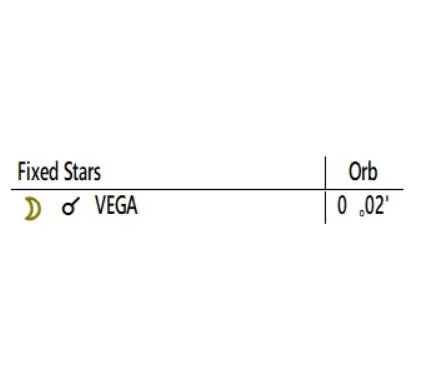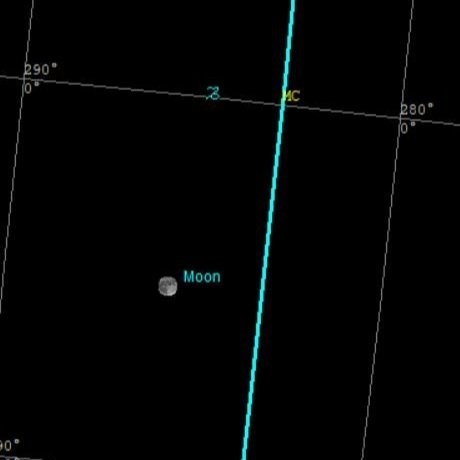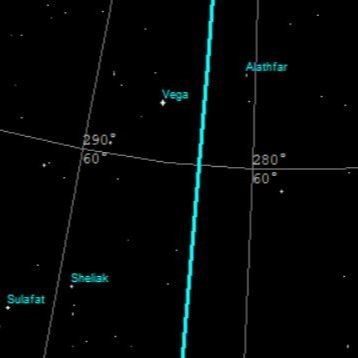Vega Talisman - Life of Heaven - Star of Healing, Incantation, & Enchantment





















Vega Talisman - Life of Heaven - Star of Healing, Incantation, & Enchantment
De Quindecim Stellis tells us, “Mild indeed is this star in all things, wheresoever I find it, for great is its arc, and great it is appearance.”
Vega, Alpha Lyrae, one of the two brightest stars in the northern celestial hemisphere , the fifth luminous star in the night sky, and was the northern pole star during the 13th-century-BCE, which it will be again in the 14-century-CE. Vega is the brightest star in the constellation of Lyra, the Lyre, held within tropical Capricorn and sidereal Sagittarius.
This talisman is known from the traditional sources of western astral-magic to confers magnanimity and eminence, offering the power of persuasion; to give power over spirits, to drive away harmful spirits and daemons effortlessly and riding one of negative nocturnal phantoms; to free the wearer of fear; to have the gift to enchant beast and find favour with animals; to keep one free of disease. It is associated with the natures of Venus and Mercury, and known as favourable star. Chrysolite and its associated virtues proceed from this star, which grant immanence, especially amongst the daemones. The associated herbs and minerals grant the bearer with unblemished health and grant power in acts of healing. Vega is known to enhance the sophistication of the powers of persuasion and accentuate one’s cunning use of arts and aesthetics.
These Vega Talismans are crafted with gem-quality golden, glowing green Chrysolite (6mm round or 6mm x 8mm oval cabochons), more commonly known as Peridot. These gems are the colour of warm seas and are marked with the Seal of Vega given in the De Quindecim Stellis and related sources. The optical qualities form the texts are given as such, “chrysolite, whose color is as the color of shining gold and doth seem as though it projecteth rays as rays of fire.” The natural virtue of this stone is said to terrify harmful spirits and daemons.
As per the instructions given in the sources, the stellar seal and the stone are to be combined with Savory and Fumitory, both associated with bestail magnetism and healting, and a small portion of Turquoise, which has been powdered.
Each talisman comes with a jute pouch and a small amount of associated herbs and resins.
They are available in Rolled-14k-Gold-on-Brass and Sterling Silver. Regarding Rolled-14k-Gold-on-Brass, these are more expensive than sterling silver. "Rolled gold" (or "filled gold") comprises a solid layer of 14k gold permanently bonded to brass. The minimum layer of gold must equal at least 1/20th the weight of the total item. It is very hard wearing and under normal wear the gold will not peel or flake, unlike gold plate, and it is commonly used as a more economical alternative to pure gold.
Regarding the election, I choose to use two elections for the full crafting of this talisman. Both involved ritual, offerings, requests, and consecrations.
The initial workings and consecrations were conducted as the Moon was conjunct Vega's zodiacal degree with the Moon connecting to Venus by trine. The Moon in this election is waxing and empowered by triplicity, Venus empowered by term and face. As Venus is the key planet linked with Vega, this connection will heighten the talismans capacity for wealth.
A second election was also integrated into these talismans to strengthen the lunar power tied to the creation. Similarly this was used to additionally consecrate the talisman. Equally, it was a clear night and the talismans were left out under Vega for irradiation alongside offerings and prayers. The Moon in this election is exalted in Taurus and empowered as the night triplicity ruler of earth, applying to Vega by Trine after having just connected to the Sun also by trine. Equally, the Moon is connected with Vega by paran, as the Moon was rising at the same exact time that Vega is culminating at the Midheaven.
Just below I explore the many-sidedness of Vega, which I can relate equally to my own practices and engagements with this Star-person and the stories they embody and radiate.
In summary, I have found that Vega’s light is like that of the Sun and the Moon, for they are circumpolar in the northern celestial hemisphere, the brightest star in the northern sky from September to December, and while only slightly second brightest to Arcturus from April to September, Vega has been, and will be again, the North Star, while Arcturus will never be able to fulfill this orientation.
Just as the light of the Sun and Moon are not easily ignored, the light of Vega for us in the northern hemisphere is impossible not to notice. Their rays shine down on us from the highest climes when both the Sun and Moon’s light is hidden. They offer an unfettered light.
They are an enchanted lyre, the healing she-goat, an ancient vulture, and a cosmic eagle. Vega is the Star of Healing, Incantation, & Enchantment.
It is, after all, the brightest star in the Lyre of Orpheus, the Thracian bard, prophet, necromancer, mage, and devotee of Apollo, whose music could make rocks and trees dance and tame all: beast, human, daemon, and god. It is also the Lyre which cunning Hermes crafted and gifted to Apollo.
Vega is the Star of Gula, meaning ‘the great’, the Mesopotamian goddess of medicine. She is a divine physician and midwife. By the 1st-millennia-BCE she was one of the main deities of the Mesopotamian pantheon and was seen as second highest in rank after Ishtar.
Vega is frequently referred to as the Goat Star, named after the asterism for which Vega is a part, the She-goat. This star, its rays, and powers, were used greatly in the practices of the Babylonians, called on to heal both man and animal. In the instructions, the star and the goddess are often referred to as one and the same. Gula is a chthonic Goddess with a dog as her companion, which along with Gula’s goat association, lead scholar Erica Reiner in Astral Magic in Babylonia to draw connections to Hecate.
Ebertin in his Fixed Stars and their Associations, offers this translation coming from the Babylonians, Vega is “The Star of the Queen of Life”. He elaborates that Vega gives artistic talents, especially for music and acting, and leads to a good and rich life. He wrote that Vega, “has a Venus nature with a blend of Neptune and Mercury.”
From the great synthesis of knowledge found in Rosenberg’s Secret of the Ancient Skies, as well as the work of many past and contemporary astral magicians, which resonates with those of other astrological traditions, we can add the following associations. Vega grants extraordinary gifts. Gifts associated with the arts and prophecy.
The Lyre is a symbol of the union of cosmic forces. The two ‘horns’ of the lyre, the union of earth and heaven, that of the four-stringed lyre, the elements, and that of the seven-strings, the luminaries and planets. It grants the divine ability to play the cosmic sympathies with great skill be it in music or magic. Equally, it gives great ability to praise the gods and the glories of the cosmos and by the power of Vega these hymns are carried into the highest reaches of the heavens.
Delving into other sources, the Assyrians named Vega Dayan-same, the "Judge of Heaven", while in the Akkadian language, it was Tir-anna, "Life of Heaven". It made up part of the astirism known as Karib-barkhati , a great celestial mountain-dwelling vulture.
In the study of Babylonian astronomy, Vega is thought to be one of the stars named Dilgan, "the Messenger of Light".
Vega is also known as Vultur Cadens. The name is believed to be derived from the Arabic term Al Nesr al Waki which appeared in the Al Achsasi al Mouakket star catalogue and was translated into Latin as Vultur Cadens, "the falling eagle/vulture".
The constellation was represented as a vulture in ancient Egypt, where vultures were seen as sacred birds that represented motherhood, protection, and the divine feminine leadership. The constellation was an eagle or vulture in ancient India.
Medieval astrolabes of England and Western Europe used the names Wega and Alvaca, and depicted it and Altair as birds.
Rosenberg writes, “The Vulture, an ambivalent symbol, is feminine and maternal, standing for solicitude, protection, shelter and love[…]as a scavenger it represents cleansing, purification, Mother Nature [Earth…]. The vulture is sacred to Apollo and is the steed of Cronus, while the Eagle, a solar symbol, stands for sky gods…ascension, inspiration, release from bondage, victory[…]. Putting together Vulture and Eagle, we have solar symbols, scavenger and hunter, one maternal, the other paternal; combined with the lyre we have the connection between heaven and earth and the sun-god Apollo, with music rising to the celestial realms, carrying song of the spirit to the high abodes of the gods. Celestial cartographers often solved the problem of the three symbols—eagle, vulture, and lyre—by depicting a raptor carrying a lyre in its claws.”
If you have concerns, please reach out, cunningasfolk@gmail.com.
